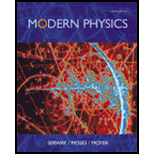
Concept explainers
(a)
The total power generated by the reactor.
(a)
Answer to Problem 25P
The total power generated by the reactor is
Explanation of Solution
Write the equation for the efficiency of the reactor.
Here,
Rewrite the above equation for
Conclusion:
Substitute
Therefore, the total power generated by the reactor is
(b)
The amount of power discharged to the environment as waste heat.
(b)
Answer to Problem 25P
The amount of power discharged to the environment as waste heat is
Explanation of Solution
Write the equation for the amount of power discharged to the environment as waste heat.
Here,
Conclusion:
Substitute
Therefore, the amount of power discharged to the environment as waste heat is
(c)
The rate of fission events in the reactor core.
(c)
Answer to Problem 25P
The rate of fission events in the reactor core is
Explanation of Solution
The value of
Write the equation for the rate of fission events in the reactor core
Here,
Conclusion:
The value of
Substitute
Therefore, the rate of fission events in the reactor core is
(d)
The mass of
(d)
Answer to Problem 25P
The mass of
Explanation of Solution
Write the equation for the mass of
Here,
Write the equation for the mass of
Here,
Conclusion:
The value of
Substitute
Substitute
Therefore, the mass of
(e)
The rate at which the fuel is converted to energy in the reactor core and to compare it with result from (d).
(e)
Answer to Problem 25P
The rate at which the fuel is converted to energy in the reactor core is
Explanation of Solution
Write the equation for the rate at which the fuel is converted to energy.
Put equation (IV) in the above equation.
Conclusion:
Substitute
The result is in agreement with part (d).
Therefore, the rate at which the fuel is converted to energy in the reactor core is
Want to see more full solutions like this?
Chapter 14 Solutions
Modern Physics
- Can someone help me with this question. Thanks.arrow_forwardIdentical rays of light enter three transparent blocks composed of different materials. Light slows down upon entering the blocks.arrow_forwardFor single-slit diffraction, calculate the first three values of (the total phase difference between rays from each edge of the slit) that produce subsidiary maxima by a) using the phasor model, b) setting dr = 0, where I is given by, I = Io (sin (10) ². 2arrow_forward
 Modern PhysicsPhysicsISBN:9781111794378Author:Raymond A. Serway, Clement J. Moses, Curt A. MoyerPublisher:Cengage Learning
Modern PhysicsPhysicsISBN:9781111794378Author:Raymond A. Serway, Clement J. Moses, Curt A. MoyerPublisher:Cengage Learning
 Principles of Physics: A Calculus-Based TextPhysicsISBN:9781133104261Author:Raymond A. Serway, John W. JewettPublisher:Cengage Learning
Principles of Physics: A Calculus-Based TextPhysicsISBN:9781133104261Author:Raymond A. Serway, John W. JewettPublisher:Cengage Learning Physics for Scientists and Engineers with Modern ...PhysicsISBN:9781337553292Author:Raymond A. Serway, John W. JewettPublisher:Cengage Learning
Physics for Scientists and Engineers with Modern ...PhysicsISBN:9781337553292Author:Raymond A. Serway, John W. JewettPublisher:Cengage Learning College PhysicsPhysicsISBN:9781938168000Author:Paul Peter Urone, Roger HinrichsPublisher:OpenStax College
College PhysicsPhysicsISBN:9781938168000Author:Paul Peter Urone, Roger HinrichsPublisher:OpenStax College University Physics Volume 3PhysicsISBN:9781938168185Author:William Moebs, Jeff SannyPublisher:OpenStax
University Physics Volume 3PhysicsISBN:9781938168185Author:William Moebs, Jeff SannyPublisher:OpenStax





